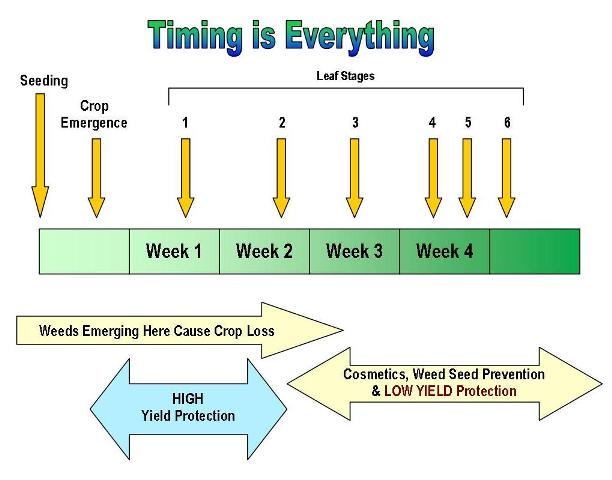Weed Control Efficiencies And Reduced Input Strategies
Make Use Of Crop And Variety Selections:
Barely and oats are generally recognized as the spring planted crops that are most competitive with weeds (fall planted cereals may be even more effective at resisting infestation by annual weeds) and can often be grown without a herbicide application. Even within these crops however, there are differences in the potential for different varieties to compete with weeds as illustrated in the table below. For example, short or semi dwarf varieties are not as competitive as tall varieties.
Table 1
| Trial Site/Variety | Silty Clay 99 | Silty Clay 98 | Sandy Loam 98 |
| Virden | 40% | 0-20% | 40% |
| Lacombe | 20% | 20-40% | 60% |
| Harrington | 100% | 0-20% | 40% |
| Condor | 20% | 20-40% | 60-80% |
| Dolly | 40% | 40-60% | 60-80% |
| Earl | 100% | 40-60% | 80-100% |
| Falcon | 40% | 40-60% | 80-100% |
| Candle | 40% | 40-60% | 60-80% |
The percentage of the registered herbicide rate required to prevent yield loss due to weeds in different barley varieties (Corey Feschuk and Doug Derksen, AAFC Brandon 1999).
In addition, the use of varieties that are resistant to disease (or other damage) in the seedling phase, will also reduce the impact of weed infestations as the best way to control weeds is with a healthy, vigorous crop.
Seeding Rates/Fertilizer Placement:
Increased seeding rates, especially of crops or varieties that are fairly cheap to plant, can reduce the potential for weeds to invade the crop canopy. In addition, placing the fertilizer close to the crop seed (but without causing injury) may give it a competitive advantage over weed seedlings that are then forced to ‘forage’ for nutrients.
Economic Thresholds:
Farmers often overlook thresholds because they can be time consuming at a busy period of the year. However, field trials have shown that the yield loss predictions listed in the Guide to Crop Protection can be effective tools when deciding if a herbicide application is necessary.
Often the question is asked about the importance of seed bank inputs of weeds that are not controlled (e.g. beneath threshold levels or late flushes). The impact of seed input on the density of subsequent infestations is difficult to determine as many factors can influence it. In general most common weeds in a field have very large and persistent seed banks that would require treatment in most years so that skipping a herbicide treatment may have little effect on long term weed numbers.. Conversely, growers may benefit from controlling a new or difficult to control weed (e.g. resistant weeds or recent invaders such as cleavers), regardless of the threshold.
Reduced Herbicide Rates:
There are two ways to reduce the amount of herbicide applied to a field. The first is to treat weed patches. Research by Alberta researcher, Linda Hall has shown that treatment of ‘obviously’ patchy weeds such as Canada thistle can save money without sacrificing weed control. As with thresholds, however, the time required to identify weed patches may be the limiting factor. The major limitation to treating portions of fields for annual weeds is the inability to adequately identify weed patches.
Other growers reduce herbicide inputs by applying reduced rates over the whole field. A healthy crop stand and good growing conditions are required for this practice to achieve satisfactory results.
Timing Of Applications
For fields that do require a herbicide treatment, proper timing is necessary for farmers to get the best value for their herbicide dollar. The research of ‘weed free periods’ for a number of crops and weeds in western Canada (including extensive trials conducted by Neil Harker, AAFC Lacombe) is summarized in the diagram below:

Timing of applications is less important for herbicides that are registered for split applications (e.g. Roundup on Roundup Ready Canola) or for those with some residual control (e.g. Pursuit or Odyssey on Smart Canola). For other herbicides though, timing is critical in order to maximize yield.
The yield potential of the crop is determined early in the season and most research indicates that weeds emerging after the 3 leaf stage of a healthy, vigorous crop have little impact on crop yield. Alternatively, the crop should be kept weed free up to the 3 leaf stage in order to maximize yields.
A preharvest application of glyphosate is the most consistent, effective control of perennial weeds.

